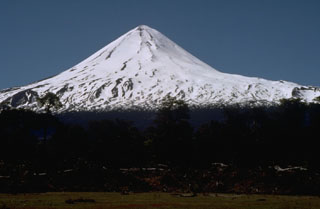Report on Llaima (Chile) — 16 January-22 January 2008
Smithsonian Institution / US Geological Survey
Weekly Volcanic Activity Report, 16 January-22 January 2008
Managing Editor: Sally Sennert.
Please cite this report as:
Global Volcanism Program, 2008. Report on Llaima (Chile) (Sennert, S, ed.). Weekly Volcanic Activity Report, 16 January-22 January 2008. Smithsonian Institution and US Geological Survey.
Llaima
Chile
38.692°S, 71.729°W; summit elev. 3125 m
All times are local (unless otherwise noted)
SERNAGEOMIN reported that eruptive activity at Llaima continued from the main crater and from two craters and a fissure on the E flank during 16-21 January. Based on observations during an overflight on 16 January, three nested pyroclastic cones within the main crater were active. The larger cone produced weak ash emissions that rose about 500 m. Ash emissions were also noted from a crater on the E flank. Glaciers on the NE slope and W flank were fractured and dislocated. Ash emissions from a NE-SW-trending fissure about 80 m in length and 10 m wide were observed. Also noted were incandescent rocks that rolled from the NE end of the fissure and ash plumes generated from rolling rocks in multiple areas during 16-17 January. On 17 January, ash emissions rose from the main crater to an altitude of 3.5 km (11,500 ft) a.s.l and drifted E. Weak Strombolian activity was seen from the main crater during aerial observation.
At 0732 on 18 January, a lateral explosion from the E side produced an ash plume that rose to an altitude of 9.1 km (29,900 ft) a.s.l. and quickly dispersed NE. Later that day, a small lateral explosion from the same area and ash-and-gas emissions from several points and new fissures were noted.
On 19 January, an explosion from the E flank produced an ash plume that rose to an altitude of 4.1 km (13,500 ft) a.s.l. An overflight revealed Strombolian activity in the main crater from a pyroclastic cone that was 120 m in diameter and 100 m high. The cone was not present during the overflight on 17 January. A second crater to the SW emitted gas. Sporadic ash emissions were noted from the E sector and an explosion produced a pyroclastic flow and an ash plume that quickly dissipated. On 20 January, another explosion produced an ash plume that rose to an altitude of 4.1 km (13,500 ft) a.s.l. Gas and ash emissions were again noted from multiple areas. On 21 January, cloud cover inhibited visual observations; one small ash emission was noted at the end of the day.
Geological Summary. Llaima, one of Chile's largest and most active volcanoes, contains two main historically active craters, one at the summit and the other, Pichillaima, to the SE. The massive, dominantly basaltic-to-andesitic, stratovolcano has a volume of 400 km3. A Holocene edifice built primarily of accumulated lava flows was constructed over an 8-km-wide caldera that formed about 13,200 years ago, following the eruption of the 24 km3 Curacautín Ignimbrite. More than 40 scoria cones dot the volcano's flanks. Following the end of an explosive stage about 7200 years ago, construction of the present edifice began, characterized by Strombolian, Hawaiian, and infrequent subplinian eruptions. Frequent moderate explosive eruptions with occasional lava flows have been recorded since the 17th century.
Source: Servicio Nacional de Geología y Minería (SERNAGEOMIN)

